With content writing, you want to find creative ways to inform and entertain your audience. But you also want to ensure your post is SEO-friendly, that readers will engage with it and that your content drives conversions. Because the fact is: brands that develop well-planned and researched content generate real results.
It’s easier said than done. We analyzed data from our tool SEO Writing Assistant, which evaluates copy for SEO potential and user-friendliness. We took the data from the last 12 months to identify the most common writing mistakes, as well as the patterns that led brands to get high or low scores.
In this guide, we’ll use this data as a lens to explore how to write relevant, effective copy that helps to get your brand noticed.
Methodology
Semrush analyzed a year’s worth of data from the SEO Writing Assistant tool between June 2020 and June 2021. The content we studied was written in English, and everything we looked at had a minimum text length of 200 words. Additionally, none of the content had been changed within the two weeks prior to us analyzing it.
The SEO Writing Assistant assigns scores to content. It looks at four main pillars: SEO, Readability, Tone of Voice, and Originality. Each pillar gets a score out of 10 — and the closer the overall score is to 10, the more optimized it is. Various aspects are influencing the scores within those pillars, with no single factor being dominant.
In our research, we classified scores in the following way:
- The highest scoring content was considered anything that scored between an 8-10.
- The lowest scoring content was considered anything that scored under a 6. We also call this “underoptimized” content.
14 Tips on how to Write Copy that’s Effective
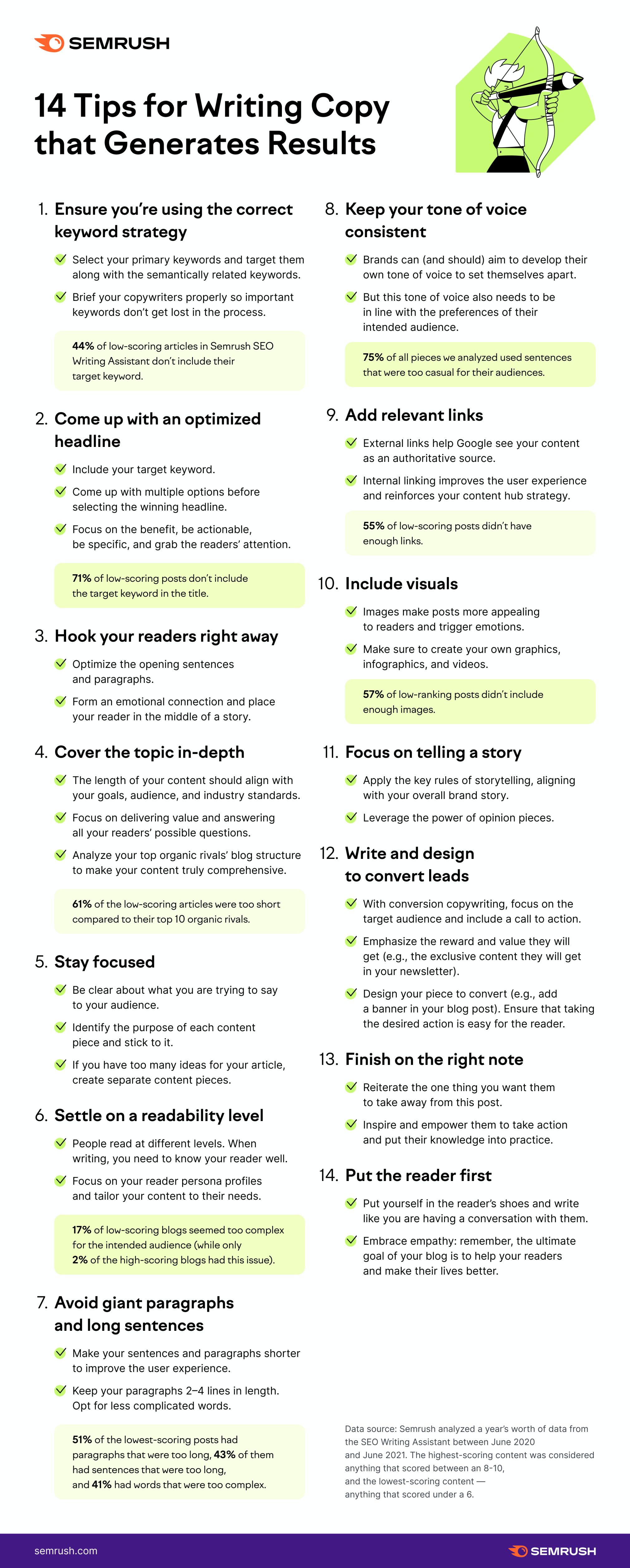
Now using takeaways from our data and the Semrush Content Writing Workbook, we’ll explore how to write copy that really generates results. Here are 14 tips:
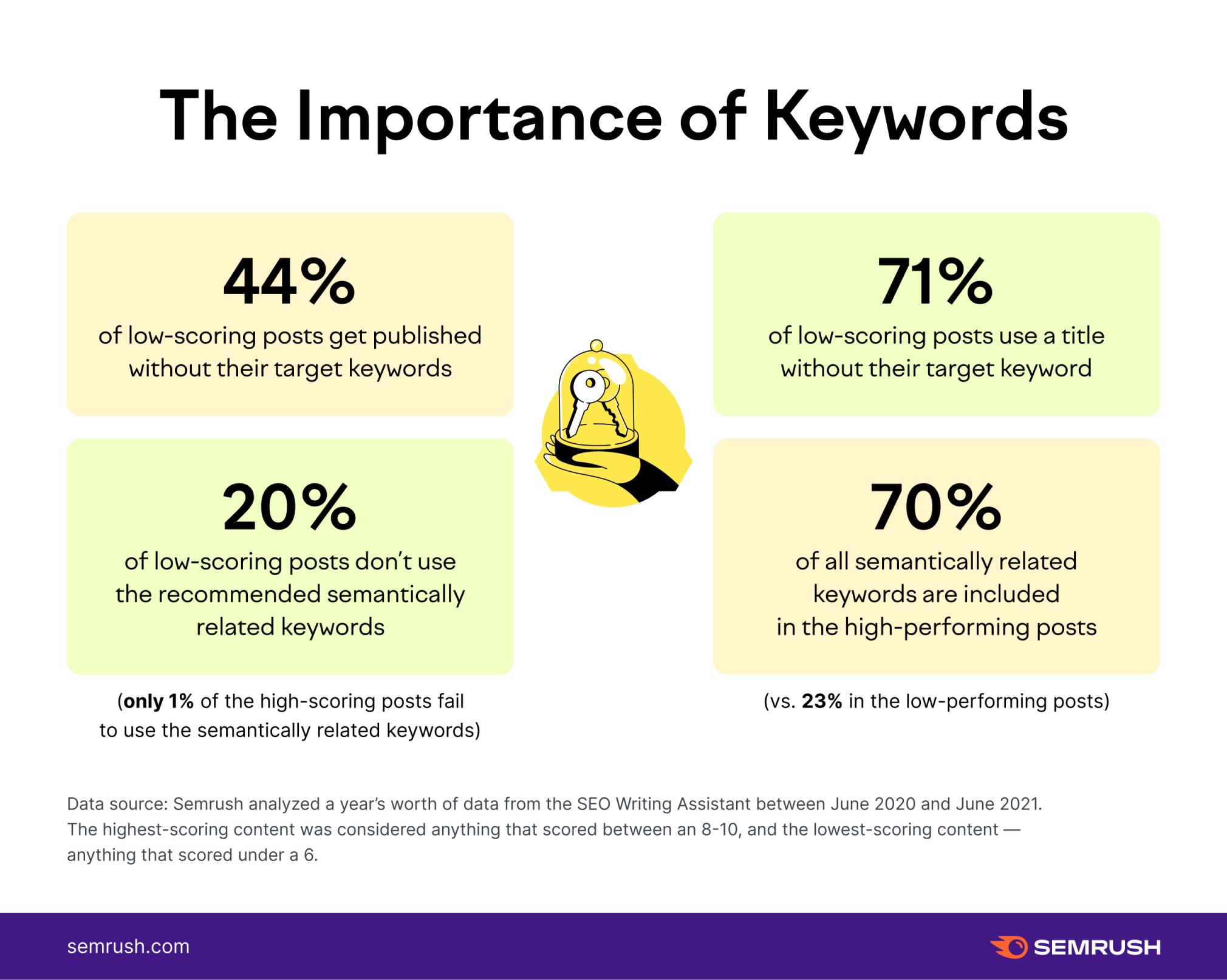
1. Ensure You Use a Correct Keyword Strategy
To write copy that drives results, you should start with keyword research. Your primary keywords — should be the focus of your article. These are keywords that 1) lots of (or some) people search for, and 2) gives you a good chance of ranking in search.
You should also support your primary keyword with semantically-related keywords. These words help search engines like Google understand what your article is about. Remember that search engines don’t only scan for perfectly matching keywords; they also try to determine the search intent and give better and more accurate results.
That said, we found something a bit surprising with our research. 44% of low-scoring posts either don’t have a defined keyword or don’t actually end up including them.
Often, this is because important information gets lost as the article moves down the content pipeline. So, how can you avoid this? Clearly define your content goals and communicate them to the writer and editor (as well as everyone involved in the piece) in a detailed article brief.
The brief should include important keywords, a short article outline, the word count, links and the target audience. Instead of having to work with limited information, this lets the writer know what type of language to use and how to angle the post to be interesting to a specific persona.
Overall, a brief puts everyone on the same page. It also ensures the copywriter can do their job: write an engaging article that helps your brand to meet its goals.
And it goes both ways. If you’re a writer, make sure a marketing manager or founder has given you all the information you need to get started before you start a blog. This will help you do your best work.
Use the Semrush Keyword Magic Tool to find your primary keywords and leverage the SEO Writing Assistant to check whether your post includes all the important semantically related keywords. Then, leverage the Semrush SEO Content Template that puts all the keywords in the brief for you, helping save time when communicating with writers.
Yet, optimizing your keyword strategy is just one of the steps you need to take to position your content for success. Keep reading!
Want to know more? Check out our recent article on how to create a writing brief.
2. Write an Optimized Headline
Want a headline that drives search results? Make sure it is optimized for both readers and SEO. The first step is to make sure your target keyword is included in it.
While it might sound obvious, our research found that 71% of the low-scoring blog posts don’t include the target keyword in their title.
But, also keep your title engaging, and make people want to invest their time in reading the piece. Ask yourself: how would your reader benefit from reading the piece? Next, make sure to reflect it in the headline! Try using a formula for high conversions in headline copywriting to really grab your reader’s attention.
Crafting headlines might also require some creativity and determination. When writing, do a lot of brainstorming. Don’t settle for the first option you came up with: challenge yourself to list five, six or even more headlines and decide on the best one.
Here are some more tips on how to write a great title:
Be Specific
Readers want to know what to expect when they click on your post. This is one reason why numbered listicles do so well. In fact, listicles get 80% more traffic compared to other article types. Listicles are also easy to scan and quick to read; depending on who your audience is, this can be a big plus.
Now, let’s say your target keyword is get a teaching job in Barcelona.
Try a title like: 10 fool-proof ways to get a teaching job in Barcelona.
Be actionable
You also want to make your title actionable. Tell readers what insights they’ll take away from your blog. Often the simpler your title is to understand, the better.
Try a title like: How to get a teaching job in Barcelona.
Sometimes, it makes sense to get even more specific. Do you have a clear idea of who will benefit from the article and their circumstances? Make sure to reflect it in the headline!
For example: How to get a teaching job in Barcelona: a guide for expats.
Grab readers’ attention
Finally, your title needs to grab people’s attention. It’s important not to over-exaggerate; don’t use hyperboles or exclamation marks. On the contrary, grab people’s attention by using clear and concise language. You can also try to draw them in by presenting them with a solution.
Try a title like: Want to get a teaching job in Barcelona? This is where you should look.
Detailing the additional value the reader gets when opening your post can also help you get more attention. For example, if there’s a checklist coming with your blog, or if the information is as up-to-date as it gets, you can showcase it as well.
For instance: How to get a teaching job in Barcelona in 2021 (with checklist).
3. Hook Your Readers Right Away
Your title is key, but it’s nothing without a good opening line. Be sure to catch the reader’s attention. There are lots of ways to do this, for example:
- Begin with a story — this can help put your reader “in the narrative” and reel them in.
When Sarita first started her e-commerce business, she had a lot of stock, a lot of debt, very little time - and no customers. It didn’t take her long to realize what she had to do.
- Use a counterintuitive idea.
Sometimes vegetables can be bad for you.
- Share a shocking statistic.
56% of statics are made up by marketers — just to convince you to buy something.*
- Include something that will resonate with the reader by speaking directly about their situation, problem, or objective.
If you are sitting in silence, worrying about how the new copyright law will affect your business, you’re not alone.
- Ask a question they can’t say no to.
Have you ever felt tired, burned out, in desperate need of a vacation?
- Use a metaphor, simile, or interesting visual description.
When Craig unveiled his business plan, the investors looked on in shock — it was as if an alien space ship had landed right there in the middle of the board room.
At the same time, you should consider how you will optimize your opening for SEO. Be sure to include your primary keyword somewhere in the opening lines.
*This is a completely made-up statistic.
4. Cover the Topic In-Depth (but Stay Relevant)
When it comes to good blogging and SEO, it’s important to go in-depth and provide a wealth of information in your piece.
According to our analysis, 61% of underoptimized articles are too short. These low-scoring articles had 604 words on average. While high-scoring blogs were 1073 words on average.
But does this mean you should always aim to make all your articles 1073 words? Definitely not. The length of your content should align with your goals, audience, and industry standards.
And, it’s important to make room for both short-form and long-form articles in your content marketing strategy. (Remember: 1000-1200 words is actually still considered short-form, while anything over this is usually considered long-form).
What really matters is your ability to understand your buyer and reader personas. For example, if you know your loyal audience engages with shorter content, you don’t always need to invest in writing a longer piece.
Try the SEO Content Template to find the optimal length for your article, based on the top 10 results. The SEO Writing Assistant will then help you make sure you are matching your recommended target.
Our research from earlier this year showed that long-read articles — those that are 7000+ in length — tend to get 4x the traffic and 1.5x the shares than average length articles.
This is proof that it can pay to be comprehensive and go into depth with your pieces when it comes to SEO. If articles are organized well with clear and easy-to-follow headings, providing lots of information also makes articles more reader-friendly. Because well, readers don’t have to go anywhere else to get the content they need.
One of the best ways to make sure you are truly covering the topic in-depth is to research your organic rivals. Once again, length is not about adding as many words as you can. It’s about answering every possible question your audience might have when searching for a specific topic.
Here’s what you can do:
- Manually inspect the top 10 articles ranking for your keyword and make notes of the headings structure in each of them. You can use the SEO Content Template to automatically generate lists of those top 10 rivals for up to 30 keywords at a time.
- Use Topic Research to find the most popular questions asked about the key topics and subtopics related to your keyword.
- Leverage the information gathered to map out the structure of your post and work on delivering as much value as you can (and aiming at doing it better than your competitors did!).
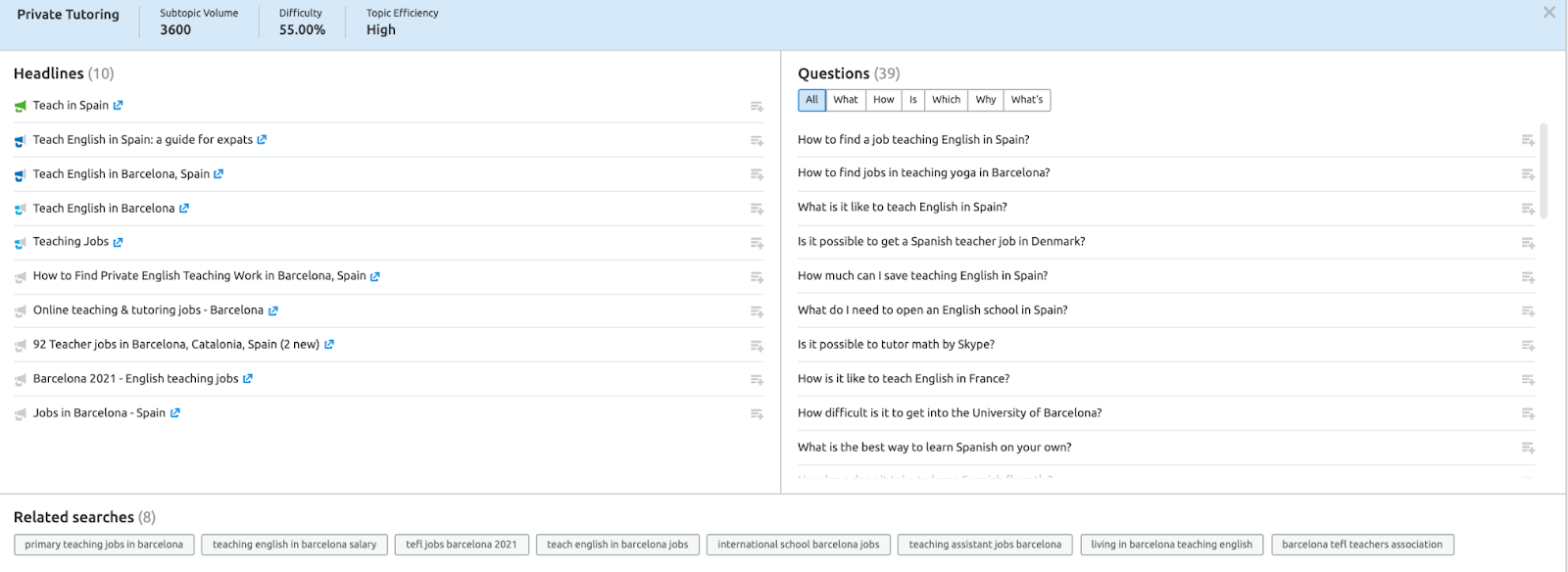
5. Stay Focused
While you want to provide lot of information to readers, you still need to stay focused.
Be clear in terms of what you are trying to say to your audience. If you pack too many ideas in, it can get overwhelming. Instead, consider creating a content hub by breaking up your larger ideas into separate (yet detailed) content pieces. This not only benefits your reader, but it also reinforces your SEO and content strategy.
Before you begin to write each article — when you’re still in the outline stage — it can be useful to assign a word count to each section or idea you'll work on. For example, try breaking up articles into 200-word bits.
When planning your content, you can also try following Henneke Duistermaat of Enchanting Marketing’s advice on writing with clarity:
- Write a brief description of your content’s purpose.
- Create a list or mindmap of what you want to include.
- Cut anything that’s irrelevant to your main idea.
- Decide whether your content will deliver on its promise before writing.
This will help you to keep your article clean and focused and help you to avoid rambling on with your words. It will also help you understand how much time and energy to dedicate to each point or idea. Finally, it will make writing good copy and long-form content feel a bit more manageable.
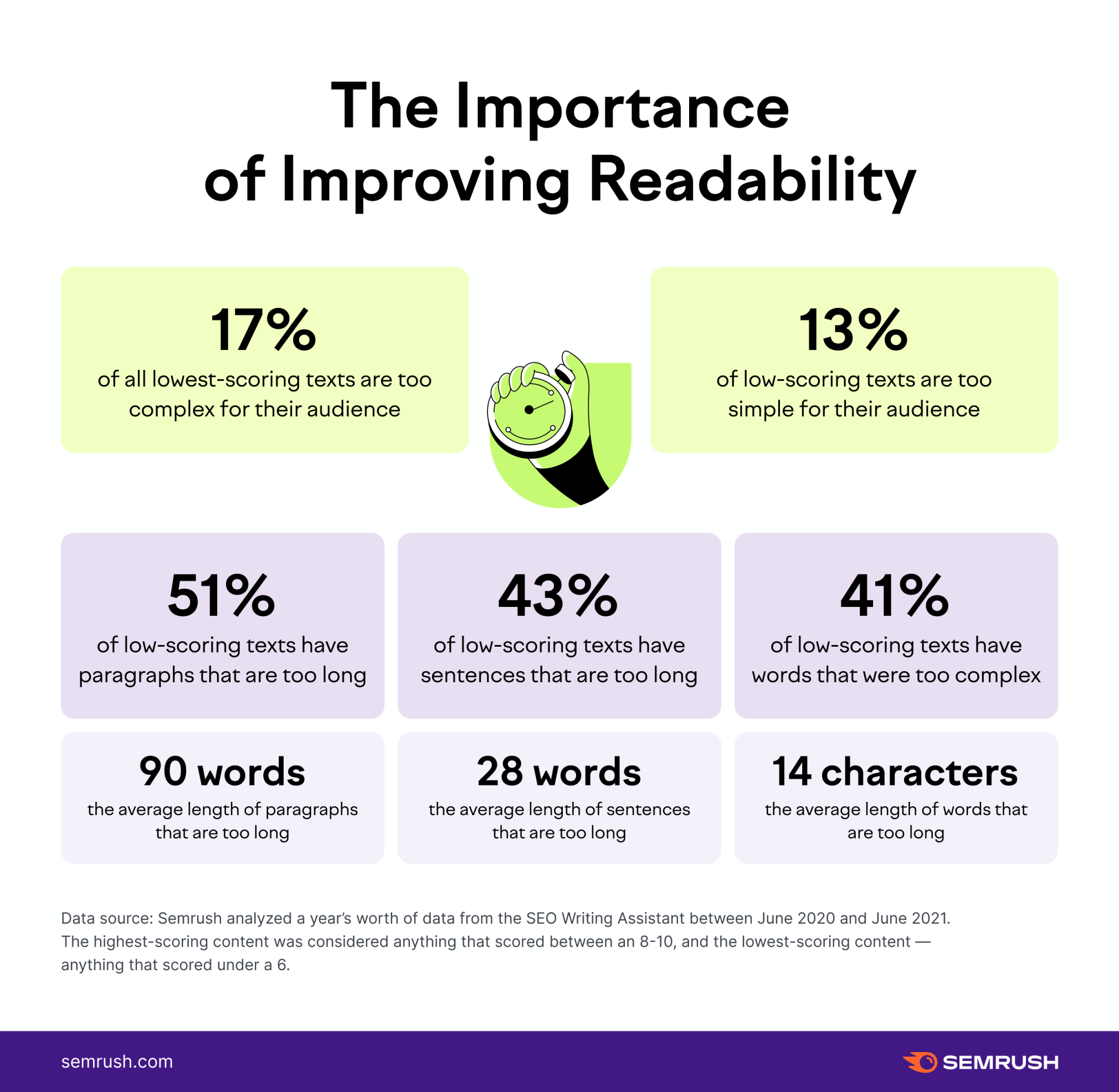
6. Settle on a Readability Level
According to our analysis, 17% of the lowest scoring blogs had low readability (only 2% of the highest scoring texts had low readability). What is means is that the text seemed too complex for the intended audience.
On the other hand, 13% of low-scoring blogs had too high readability, because the text seemed too easy (only 4% of the highest-scoring pieces had overly high readability).
This hurts the way your content is engaging your target audience and negatively affects its SEO-friendliness. And perhaps worse — it could also cause readers to quickly lose interest in your post.
To write good copy, it’s imperative to do audience research. We recommend creating a reader persona for your readers (or ideal clients) by collecting data on things like their demographics, psychographics, pain points, and goals. You can also collect information on what influences your readers or what other media they consume.
Note that we’re talking about reader personas rather than the more common “buyer personas.” With our content, we don't always only want to attract buyers — that’s a much narrower audience, after all. Sometimes we are happy to attract people to our website who'll simply share our content and become brand advocates.
As we wrote in our content development guide, “the more you learn about their demographics, psychographics, interests, and needs, the more high-quality, relevant content you’ll be able to create.”
At Semrush, our SEO Writing Assistant calculates your content’s readability score using the Flesch-Kincaid readability test, developed in the 1970s for the U.S. Navy. The higher your readability score, the easier your text is to understand. We look into the average readability score of your top 10 competitors to pinpoint what your goal should be.
7. Avoid Giant Paragraphs and Long Sentences
We found that 51% of the lowest-scoring posts had paragraphs that were too long. These paragraphs were 90 words, on average. And, 43% of the lowest scoring posts had sentences that were too long. Across all the texts we analyzed, the average length of long sentences was 28 words.
Here’s an example of a sentence that has been highlighted as too long in the SEO Writing Assistant:
“When an individual is stuck at a crossroad between their values and beliefs and the current situation and can not make up their mind to what to do, they always have counseling at their rescue, and counseling can help a person clear the indecisiveness and come to a decision when stuck with a difficult question that life throws at them.”
It could be rewritten as:
“Sometimes an individual is stuck at a crossroad between their values, beliefs and the current situation, and can not decide what to do. Luckily, they always have counseling at their rescue. Counseling can help a person come to a decision when stuck with a difficult question that life throws at them.”
We also found that 41% of the lowest-scoring posts featured overly complex words: The average length of these words is 14 characters.
Our simple advice? Keep your sentences and paragraphs shorter (which equals easier to understand and more clear). Also, opt for shorter words rather than long ones — e.g., “use” versus “utilize,” “host” versus “accommodate,” etc.
Here are some other examples of complex words identified by the SEO Writing Assistant: “ultra-contemporary,” “overindulging,” “susceptibility” and “uncharacteristically.” So, you get the idea.
All this will help you improve the user experience, boost engagement, and, ultimately, positively impact your SEO. Keeping your writing clear and concise, making articles easier to read is always a good idea — whether you’re writing for teenagers or PhDs.
One good tip? It can help to be mindful about how your article looks visually on the page. With blog writing, try to keep your paragraphs 2-4 lines in length.
And if a few paragraphs look too long, don’t hesitate to hit enter. You can make this part of your editing process, too. If you are using the SEO Writing Assistant, you will get instant recommendations on which sentences, words, and paragraphs need to be modified.
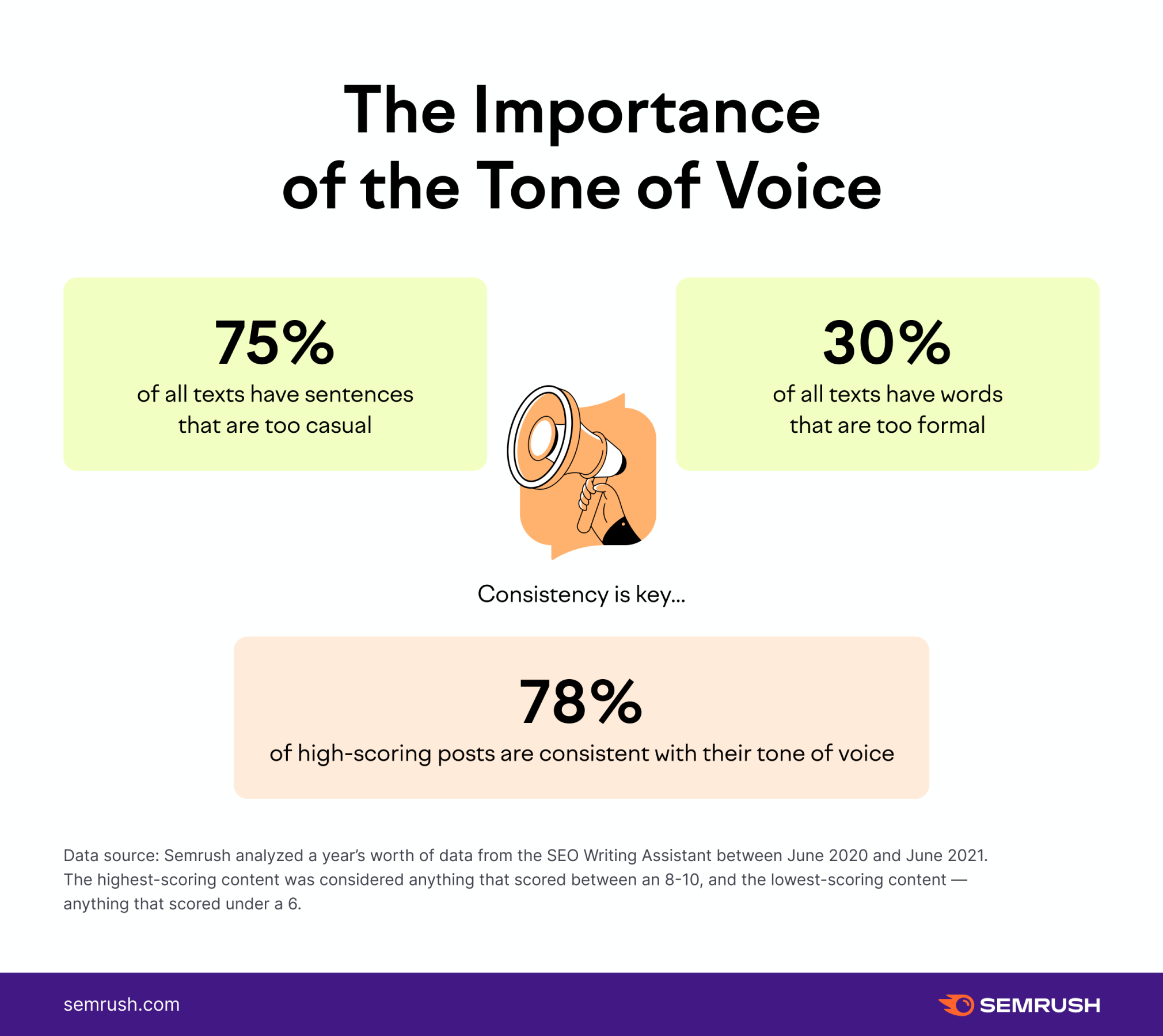
8. Keep Your Tone of Voice Consistent
Tone of voice is all about how you communicate with clients and readers via your blog and content — and it determines how your brand is perceived. Do you want to come across as more casual, by writing in second person (you) or by starting sentences with “and” or “but”? Or do you prefer to be more formal through using precise language and longer words?
Writing in the correct tone of voice is easier said than done. 75% of all the pieces we analyzed used sentences that were too casual, while 30% of all the pieces we analyzed had sentences that were too formal.
Here’s an example of a sentence that the SEO Writing Assistant identified as too casual for a specific piece (and hence affecting the tone of voice consistency):
“It was not only the best tour we took in New York... and the BEST BUS TOUR we have EVER taken!!!”.
This is, on the contrary, a sentence identified as too formal:
“Board training can also improve proprioception, or the perception of your body's position and movements in three-dimensional space.”
So, is there a middle ground? Your brand can (and should) aim to develop its own tone of voice to set itself apart. However, how you write should also depend on who the audience is and your aim for any particular piece of content. Once you do audience research, you will understand what makes your readers tick — and what kind of media they want to consume.
To streamline this process, refer to the recommendations the SEO Writing Assistant provides on adjusting your tone of voice and making it more consistent.
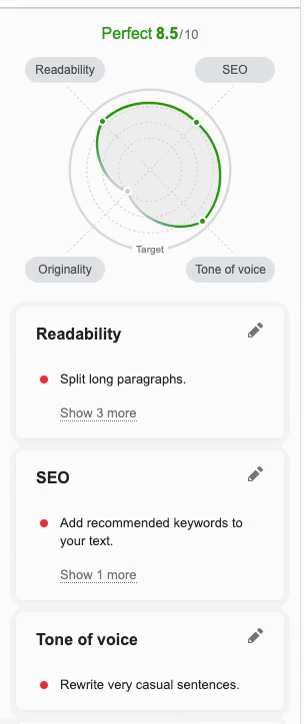
To delve in further, check out our recent blog: how to define your brand’s voice.
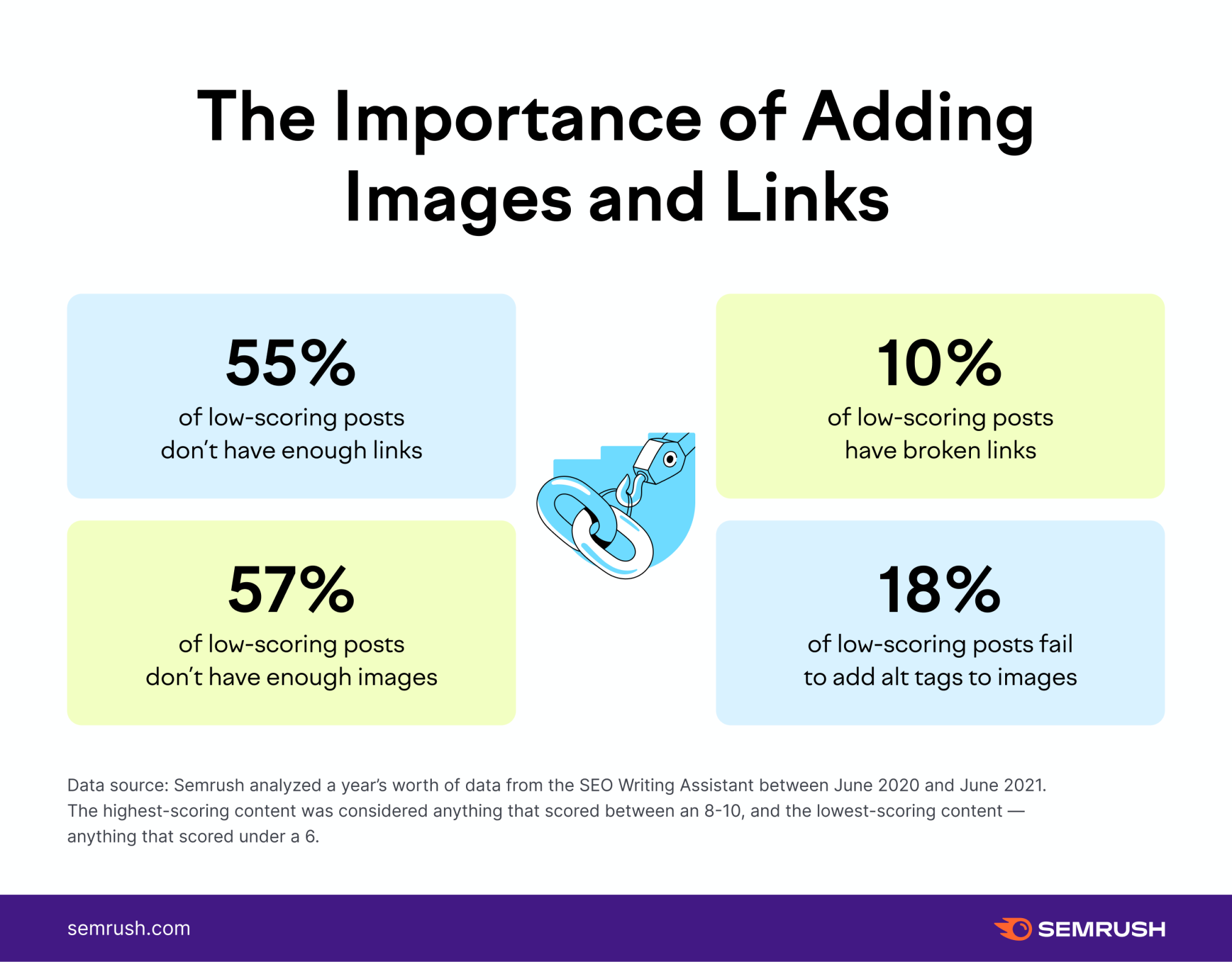
9. Add Relevant Links to Create a Better Experience (and Please Google)
Incorporating links into your content is an important component of SEO. But many brands struggle with it. In fact, we found that 10% of low-performing pieces had broken links, while 55% didn’t have enough links.
Internal links help users discover more great content on your website and help search engine bots to index your site, which is an essential part of any topic cluster strategy. Also, using links that point back to solid research encourages the readers to see you as a more authoritative source — thus building trust with your audience.
To catch broken links in your content drafts, use the SEO Writing Assistant. You can quickly and easily ensure links are in working order and that your content is performing the best it can.
10. Include Visuals to Boost Engagement
Yes, pictures matter! Our analysis found that 57% of low-ranking posts don’t include enough images. Not only this, but a February Semrush survey found that blogs with at least one picture get 2x the traffic than those without. They also get shared 30% more of the time and get 25% more backlinks.
So, enriching your text with images makes posts more appealing to readers and causes more people to engage with them.
Don’t limit yourself just to pictures, though. Creating your own video, graphics, and infographics is an excellent way to fill your posts out with multimedia content. They’re also an easy and creative way for people to consume information in your post.
They can then be used on social media to engage with readers and clients there, which can help further build your brand identity. Finally, it’s an excellent way to get more backlinks and shares of your content.
11. Focus on Telling a Story
Writing isn’t just about sharing information. It should also make people feel in a certain way, even if you are in a B2B market. And there are lots of creative ways to do this through storytelling.
Not only can storytelling be persuasive, but it draws the reader in — helping them imagine that they are the hero in the narrative. This makes the copy considerably more memorable. At the same time, emotions form a big part of the decision-making process.
According to Eddie Shleyner, the founder of VeryGoodCopy.com and a contributor to our writing workbook, using descriptive language in your piece is an excellent way to bring the audience into your narrative.
Good copywriting (and storytelling in general) often hinges on the writer’s ability to put an image in the mind’s eye of The Reader. Because images — clear, relevant, vivid images — trigger emotions, which move people.
He says this can be done by focusing on something specific. Let's say you’re writing about working remotely. Describing images like slippers under a desk or a partner making breakfast in the kitchen can all make people better relate to your content.
Another way to push along your narrative is through sharing a strong opinion.
As Andy Crestodina — the Chief Marketing Officer and Co-Founder of Orbit Media Studios — writes in the Semrush Content Writing Workbook, this can feel risky for a lot of brands. “But it’s often very effective for the programs that do it, because so few brands are willing to try,” he writes.
That’s why content based on a strong opinion is automatically differentiated. It feels different. It gives the audience something to talk about. It has big advantages in social media and often leads to very loyal followings.
12. Write (and Design) to Convert Leads
All of your content should be written with conversions in mind. You don’t always need to be trying to close a sale. Depending on where your leads are in the funnel, a conversion could also mean getting people to sign up for your newsletter or download an ebook.
Either way, to optimize your content for conversion, it’s important to focus on three elements:
- Your target audience
- Your ability to write persuasively
- Your call to action (CTA)
As we mentioned above, determining who your target audience lets you understand their goals and pain points — allowing you to then address these in your copy.
- With conversion copywriting, you also want to write in a way that’s persuasive. There’s no need to be “salesy,” even if you are thinking about your conversion rates.
- Instead, focus on being conversational. You can also use punctuation (who doesn’t love a good em dash?) to drive the points you really want to make and highlight why your products are important.
- Finally, your CTAs must be clear, concise — and well-designed. They should be designed to help the reader take action, so think of them as instructions. It’s often a good idea to use verbs to lead into them (book now, read more, learn about, talk to, etc.), as they make the sentence more dynamic and help drive people to action.
For example, banners that stand out at the top and bottom of your piece, and leads to take action, often work well. Working on making those more functional — e.g., by letting your user to submit a form integrated in the banner without leaving the blog post page — can bring its advantages.
What’s key here is to make sure it’s easy for your user to:
- Find the CTA
- Understand the value they will get in exchange for taking the action
- Take the desired action (e.g., by making sure the form is easy to fill out)
In other words, make sure the value from converting is higher than the expense in the eyes of your users (e.g., spending time to submit a form and giving away an email).
Read more about optimizing your content for conversions in our blog : The Complete Guide to Content Optimization (+Infographic).
13. Finish on the Right Note
Readers will interpret your content however they like. It’s therefore essential to continually signpost what you think is important and what you want them to take away from the piece. So, as you wrap up the article, be sure to reiterate the one thing you want them to remember or put into action.
Use your conclusion to inspire and empower them to put their knowledge into practice. Think about the following:
- What got your reader to open the article in the first place? Make sure you reinforce this message in your conclusion.
- If your post is about helping your reader do something, summarize their next steps and be clear about how your business or service will help them (if applicable).
- Remind the reader of their vision and tell them they can achieve their goals if they walk through your steps.
- Encourage your reader to comment on the article by asking relevant questions.
- End on an uplifting note about the future.
14. Always Put the Reader First
Finally, for articles to really shine, they should be written for readers first. It’s what Henneke Duistermaat argues in the Semrush Content Writing Workbook. Henneke is an author of two books and several acclaimed courses on copywriting and says focusing too much on content strategy can cause blogs to fall short.
So, imagine you are writing for one person. What are their aims and challenges? How can your blog posts help improve their lives? This is the starting point for empathy, and empathy for your readers makes your writing more engaging.
She says it helps to step into the shoes of the reader and think about the questions they might have. Then, write as if you were having a conversation with them. This helps your writing to become more human. “It’s almost as if you were writing a letter.”
Semrush Tools to Help You Master Copywriting
- Our Topic Research Tool analyzes your competitions’ content and provides you with content ideas for your topic/topic cluster, including subtopic ideas, related questions and headline ideas.
- Our SEO Content Template delves into your competition’s content (that is, the top-10 ranking pages for your target keywords) and gives you recommendations on how to write SEO-friendly pieces.
- Our SEO Writing Assistant lets you check the SEO and engagement potential of your piece in real-time — things like readability, tone of voice, recommended keywords, and originality. You can also use it as Google Docs and WordPress add-on.
In Conclusion
Remember: writing before anything is an art. And to hone your skills in any art, you need to spend lots of time-consuming it. To write great copy, you need to read, read, read — and read some more.
Don’t just read your competitors' blogs. You should also spend time with novels, news articles, magazine features, and other non-fiction work. The more different writing you read, the closer you’ll come to developing an original voice and style of story-telling for your brand.
To explore more about SEO copywriting, download our content writing workbook, The Semrush Content Writing Workbook, which includes information on how to improve the quality and efficiency of content production.
